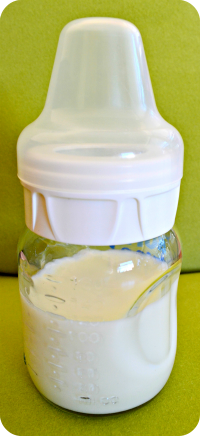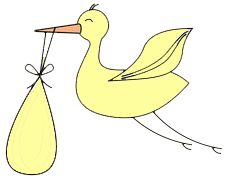Weight Gain – Weight Game. Is Milk Composition to Blame?
Mother's milk is ideally the best food for the baby. Milk composition, however, varies mother to mother and depends on many factors.
In some cases it happens so that the composition and quality of mother's breast milk needs improvement.
When the baby starts sucking foremilk comes first, followed by the thick, creamy and calorie-rich hindmilk. Hindmilk is the lifeblood for babies. It brings saturation, nutrients and calories.
Some babies have to do quite some sucking to get to the hindmilk, because it is harder to get out. Some moms' hindmilk resembles foremilk in quality.
Testing Milk Quality

To see what your hindmilk is like, do the following test:

-> If you have some previously pumped milk and you occasionally bottle-feed your baby, feed your baby this saved milk at a regular feeding time.
-> Then pump both breasts.
-> Pour milk from each breast into a separate see-through container.
-> Let this newly pumped milk sit in the fridge overnight.
-> Look at the containers in the morning.
↓
- You should see a thick layer of creamy, fatty hindmilk at the top. If so, your milk quality is just fine. Do this test a couple of times to check consistency.
- If the milk is bluish, doesn't have a good layer of creamy hindmilk at the top or has a watery taste, talk to your doctor. Some dietary and lifestyle changes may be required.
Different Types of Weight-gainers
Baby's weight gain is not always a direct reflection of what mother's milk is like. Some babies' physiological build-up prevents them from gaining weight well. Look at these 2 types of weight-gainers:
LEAN BABIES. Your baby may be breastfeeding well and getting a lot of milk, but because of poor milk composition may not be gaining weight as needed.
This is how my son was. Even when he was eating a lot, he was not gaining weight well. He was also asking for more frequent meals (more often than every 2 hours). Low-fat milk is digested faster and more easily, which makes babies hungry more often.
Such babies are lean. They have a normal daily number of wet diapers (6-8). But only one bowel movement per day or every other day (with the norm of at least 3). Low number of soiled diapers is a sign that the baby doesn’t get enough calories with breast milk.
These babies get hungry soon after the feeding. They look different too. Generally babies have lots of fat under the skin. These babies don’t. If you pull their skin, it wrinkles and is not firm at all.
Do the test above and let your doctor know if you suspect poor milk quality. He should be able to recommend some dietary and lifestyle changes.
In most cases breast milk quality can be changed by adjusting your diet. Increase you protein, fats and carbohydrates intake.
Milk-making mechanism is usually able to get these nutrients from your body reserves, if not from your meal. But if your body reserves are exhausted, your milk quality will suffer.
If a detailed milk composition test
is not available in your area, make sure that you eat a lot of cottage cheese,
meats, eggs, butter, baked goods and breads. And watch your milk change. Visit Breastfeeding Diet section to read more.
TALL BABIES. Another category of poor weight-gainers is tall babies. These babies are lean, because most of the calories are used up for their height rather than weight.
These babies have a normal number of bowel movements and their skin is
not wrinkled. Their build-up can’t be changed by dietary changes. This is just how they are: lean and tall.
As you may see, weight gain is not a perfect world and should not be followed
blindly. Your baby's doctor is the best to judge about whether or not your baby is getting everything he/she needs with your milk. Watch your baby and seek help if in doubt.
|
Breastfeed Happier Today! Never miss a thing from Breastfeeding Quest! This free newsletter will keep you up-to-date with new articles on our website and deliver special offers, discount codes and product reviews straight to your Inbox. Subscribe Now! |
 |
Home › Breastfeeding Problems › Milk Composition










